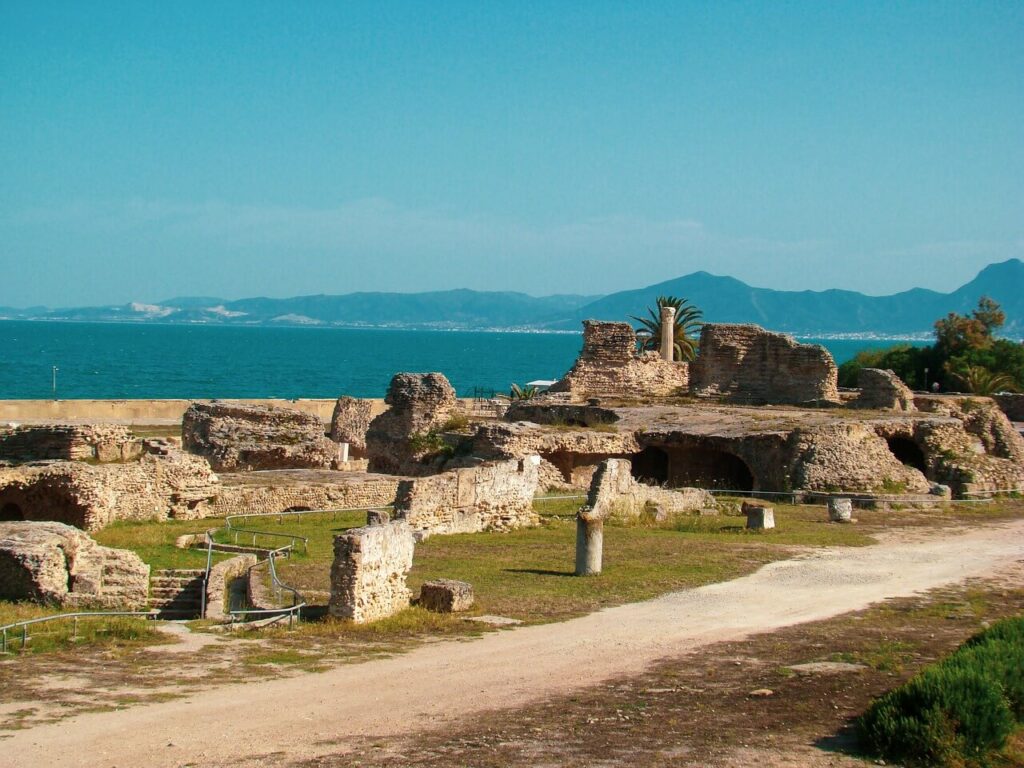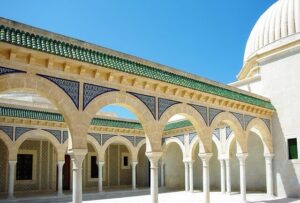Table of Contents
- Introduction to Carthage
- History of Carthage
- Economy and Culture
- The Ruins of Carthage
- The Legacy of Carthage
- How to Get to Carthage
- FAQ
Introduction to Carthage
Carthage, an ancient city that deeply marked the history of the Mediterranean, is located in modern-day Tunisia. Founded in the 9th century BCE by the Phoenicians, it was the heart of a powerful commercial empire that extended across much of the Mediterranean. The ruins that can be visited today tell a story of greatness, wars, and eventual destruction, offering visitors a fascinating glimpse into an extraordinary civilization. Today, it is one of Tunisia’s top attractions, captivating visitors with its historical remains and rich cultural heritage. Located near the capital Tunis, this ancient city remains a symbol of resilience and past splendor. With its unique blend of history and culture, this city is a must-see for those who want to discover the roots of Tunisia and the ancient Mediterranean world.
History of Carthage
Foundation and Rise
Founded around 814 BCE by Phoenicians from Tyre, it was strategically located along Mediterranean trade routes. This made it a hub for luxury goods such as ivory, gold, spices, and fine textiles, bringing prosperity and wealth to the city. With an advanced naval fleet, Carthage became a dominant commercial power, founding colonies along the coasts of North Africa and the western Mediterranean. Its power grew quickly, and the city became a rival to other Mediterranean powers like Rome and the Greek city-states. Strategic alliances and control of trade routes allowed Carthage to expand its empire, becoming one of the most powerful and influential civilizations of the ancient era. In addition to its commercial strength, it was known for engineering skills and innovations in navigation. Its ships and shipbuilding techniques became renowned across the Mediterranean.
The Punic Wars
The Punic Wars were three conflicts that determined the fate of Carthage and Rome. The First War (264–241 BCE) saw Carthage lose control of Sicily. The Second War (218–201 BCE) is famous for Hannibal’s campaign, where he crossed the Alps with his elephants to attack Rome. Despite initial victories, the city was defeated. The Third War (149–146 BCE) culminated in total destruction, with Rome razing the city to the ground. The war against Rome marked a dramatic moment in Carthage’s history, leading to the end of its independence. The Punic Wars were a testament to the city’s tenacity, which, despite defeats, retained its fighting spirit. This fall marked a turning point in Mediterranean history, consolidating Roman influence and shaping the course of European and African history.
Economy and Culture of Carthage
Economy of Carthage
Carthage’s economy was dominated by maritime trade, thanks to its strategic position in the Mediterranean. The city controlled trade routes and exchanged luxury goods such as ceramics, spices, and textiles with the rest of the ancient world. Agriculture was also developed, with the cultivation of grains, olives, and vines. The city also had a solid manufacturing industry, known for producing high-quality ceramics and fabrics. Its artisan crafts flourished, with workshops creating jewelry and luxury goods for an elite market. Its economy, based on navigation and trade, is one of the reasons why the city became a magnet for different cultures and peoples of the Mediterranean.
Culture and Religion
Carthaginian culture was a blend of Phoenician, African, and Mediterranean influences. Religion played a fundamental role, with main deities such as Baal Hammon and Tanit. Religious practices included ritual sacrifices, a feature that drew criticism and astonishment from other civilizations. It was also a center of culture and learning, influenced by the arts and architecture of neighboring civilizations. Visual arts and music were an integral part of Carthaginian life, reflecting the city’s unique identity. Worship and traditions represented an important pillar for the community, which identified with its religious history and beliefs.
The Ruins of Carthage
The ruins, located near Tunis, are a major tourist attraction and protected by UNESCO. Key remains include the Baths of Antoninus, the Punic Port, the amphitheater, and numerous necropolises. The Baths of Antoninus, once a leisure site for Roman nobility, are a testament to the architectural grandeur of the time. The Punic Port, the core of naval power, showcases Carthaginian engineering skills. Visiting the ruins of Carthage allows one to dive into the past and understand the complexity of Carthaginian civilization and its role in Mediterranean history.
The Legacy of Carthage
Despite its destruction, the legacy still lives on today. The city deeply influenced the history and culture of the Mediterranean. Contributions in naval engineering, trade, and diplomacy have left a lasting mark. The city continues to be a symbol of resilience and ingenuity, and its ruins are a testament to the greatness of this civilization. It remains a source of inspiration and a subject of study for history enthusiasts.
How to Get to Carthage
The most practical way to visit is to fly to Tunis. The Tunis-Carthage International Airport offers connections to many European cities. It is also possible to take a train to the city from central Tunis. Alternatively, the city is easily accessible by taxi or car from Tunis, which is about 15 km away. Public transportation is a convenient and scenic option.
FAQ
- When was Carthage founded? It was founded around 814 BCE by Phoenicians from Tyre.
- Where is Carthage located today? It is in present-day Tunisia, near the capital Tunis.
- What were the main causes of the Punic Wars? The main causes were the rivalry for control of the Mediterranean between Carthage and Rome.
- What can be seen today among the ruins of Carthage? Main remains include the Baths of Antoninus, the Punic Port, the amphitheater, and various necropolises.
- How can one get to Carthage? The most common way is to fly into Tunis-Carthage Airport and then take a taxi, train, or car to reach the site.
- What is the historical importance of Carthage? It was one of the greatest powers of the ancient world, influencing trade, culture, and politics of the Mediterranean for centuries. Its history is crucial to understanding the dynamics of the ancient world and the rise of Rome.
Conclusion
The history of Carthage is a fascinating tale of rise, power, and tragic end. From its foundation as a Phoenician colony to its commercial and military dominance over the Mediterranean, Carthage left an indelible mark on ancient history. Its epic battles against Rome during the Punic Wars remain among the most gripping chapters in history. Today, the ruins offer visitors a unique window into the past, allowing them to imagine the greatness of this lost civilization. Its legacy continues to live on, reminding us of the complexity of cultural interactions and the dynamism of the ancient world. Visiting Carthage is an experience that enriches one’s understanding of Mediterranean history and testifies to the resilience of the human spirit through the centuries.
Here is a short video:






